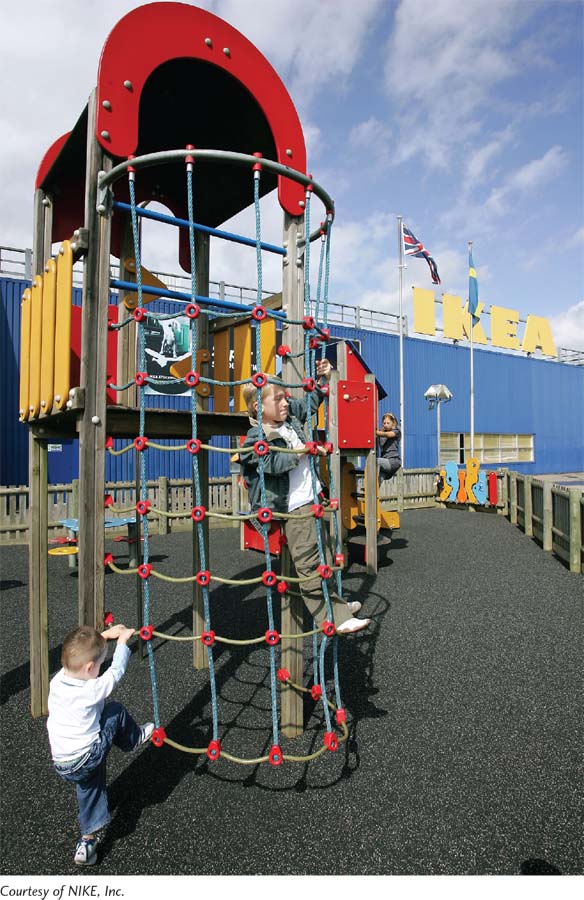Reuse-A-Sneaker
In the 1990s, athletic shoe manufacturer Nike, based in Beaverton, Oregon, drew a great deal of negative publicity for the conditions of its factories and treatment of its workers overseas. The prevalence of child labor, unsafe working conditions, and inadequate wages highlighted the social costs that often accompany commercial success. Environmental degradation was the most pressing unseen effect of a very profitable shoe manufacturing company. However, in subsequent years, Nike imposed a system of factory standards and inspections that, along with recently passed labor laws in countries like China, have considerably improved conditions for workers.
Unlike heavy industry and energy generation, the shoe industry is not often part of the environmental discussion in the United States. However, in Asian and South American countries where the factories are located (one-third of Nike shoes are produced in China), the environmental impacts of shoe manufacturing are far more visible. Many aspects of production reduce the quality of air, water, and soil both near and far from production plants, including emissions from energy use and transportation of materials and products, solid waste from all levels of production, and resource extraction prior to manufacturing. Besides these threats, workers are often exposed to the toxic solvents, adhesives, and rubber used in shoe fabrication. The evaporation of these substances contributes to the concentration of volatile organic compounds (VOCs) in the atmosphere. VOCs also cause respiratory impairment in factory employees and contribute to hazardous waste. As shoe companies like Nike continue to increase production, the environmental effects are compounded. However, Nike is making significant efforts to lessen the environmental cost of a successful business.
In order to improve the sustainability of its industry, Nike has developed a comprehensive cradle-to-grave program that addresses environmental impacts in every stage of raw material extraction, product fabrication, sale, and disposal. The “Nike Considered” program offers more sustainable products and provides an index that evaluates each product and assigns it a score based on its environmental impact. Factors considered include efficiency of design, solvent use, and waste creation. Essentially, Nike has created a life-cycle analysis of materials including extraction processes, energy and water use, manufacturing practices, and recyclability. Products labeled “Considered” must meet standards of sustainability significantly higher than the average Nike product. These products are made using water-based adhesives instead of solvent-based adhesives, thereby reducing VOC evaporation. Soles of the shoes consist of recycled and less toxic rubber. The design of the shoe as well as the manufacturing process must demonstrate efficiency. Many Nike products already follow the “Considered” standards. Nike intends for all products made by it and its affiliates to be manufactured following the “Considered” standards, at which point waste will decrease by 17 percent and use of environmentally preferable materials will increase by 20 percent. As part of this program, Nike has created a Sustainable Business Performance Summary.

Nike Grind. Making this athletic playing surface from recycled sneakers and sneaker manufacturing waste saved resources and energy.
(Courtesy of NIKE, Inc.)
In addition to designing and fabricating more sustainable shoes and supporting organic agriculture, Nike reduces waste and positively affects communities through its Reuse-A-Shoe program. The company encourages the public to recycle used athletic shoes so that they can be broken down into a substance called Nike Grind. Nike Grind is the raw material that results from the recycling of athletic shoes collected through Nike’s Reuse-A-Shoe program and from the recycling of scrap materials left over from the manufacture of Nike footwear. By recycling old shoes and manufacturing scrap, and incorporating this recycled material into sports surfaces and new Nike products, the program reduces landfill waste and reduces the need for extraction of raw materials for athletic facility surfaces. Additionally, Nike athletic shoes are now designed for easier breakdown, which decreases the energy needed to create Nike Grind. Nike has partnered with market-leading sports surfacing companies that use Nike Grind in the manufacture of tennis and basketball courts, running tracks, synthetic turf, children’s playgrounds, and fitness room flooring, doubly benefiting the environment and the local population. Nike estimates that more than 25 million pairs of shoes have been recycled in the Reuse-A-Shoe program.
In April of 2009, volunteers used Nike Grind to build the first community playground in the Poncey-Highland neighborhood of Atlanta, Georgia. The rubber surface consisted of 92 percent recycled materials, and equipment was constructed from recycled milk jugs and other reused products. By using cradle-to-cradle practices to reduce environmental damage and support social programs, Nike is working to achieve a more ethical and sustainable business model. Presumably, over time, more companies and industries will develop innovative sustainable business practices. Sustainable practices are an essential part of being a consumer, but they may also become part of business and industry.
Critical Thinking Questions
What are some of the obstacles that prevent businesses from adopting sustainability goals and actually practicing sustainability in the workplace?
Can you identify and describe a sustainable business in your community?
Locke, R. M., et al. 2009. Nike Considered: Getting Traction on Sustainability. MIT Sloan Teaching Innovation Resources (MSTIR). https://mitsloan.mit.edu/LearningEdge/sustainability/NikeConsidered/Pages/default.aspx.
Sharma, A. 2013. Swoosh and sustainability: Nike’s emergence as a global sustainable brand. Sustainable Brands www.sustainablebrands.com/news_and_views (May 17, 2013).
 sustainability
sustainability